Dynamic Mode Decomposition of Fluorescence Loss in Photobleaching Microscopy Data for Model-Free Analysis of Protein Transport and Aggregation in Living Cells
Abstract
1. Introduction
2. Materials and Methods
2.1. Cell Culture and Transfection
2.2. Image Simulation
2.3. FLIP Microscopy of Fluorescent Proteins in Living Mammalian Cells
2.4. Outline of the DMD Method Applied to Fluorescence Microscopy Data
3. Results
3.1. DMD of Simulated FLIP Image Sequences
3.2. DMD of Experimental FLIP Image Sequences of Nucleo-Cytoplasmic Exchange of eGFP
3.3. DMD of Experimental FLIP Image Sequences of Soluble and Aggregated eGFP-mtHtt
4. Discussion
5. Conclusions and Outlook
Supplementary Materials
Funding
Institutional Review Board Statement
Informed Consent Statement
Data Availability Statement
Acknowledgments
Conflicts of Interest
Appendix A. Derivation of Analytical Solution for FLIP Simulation
Appendix B. FLIP Simulation with Moving Aggregates and Their DMD Reconstruction
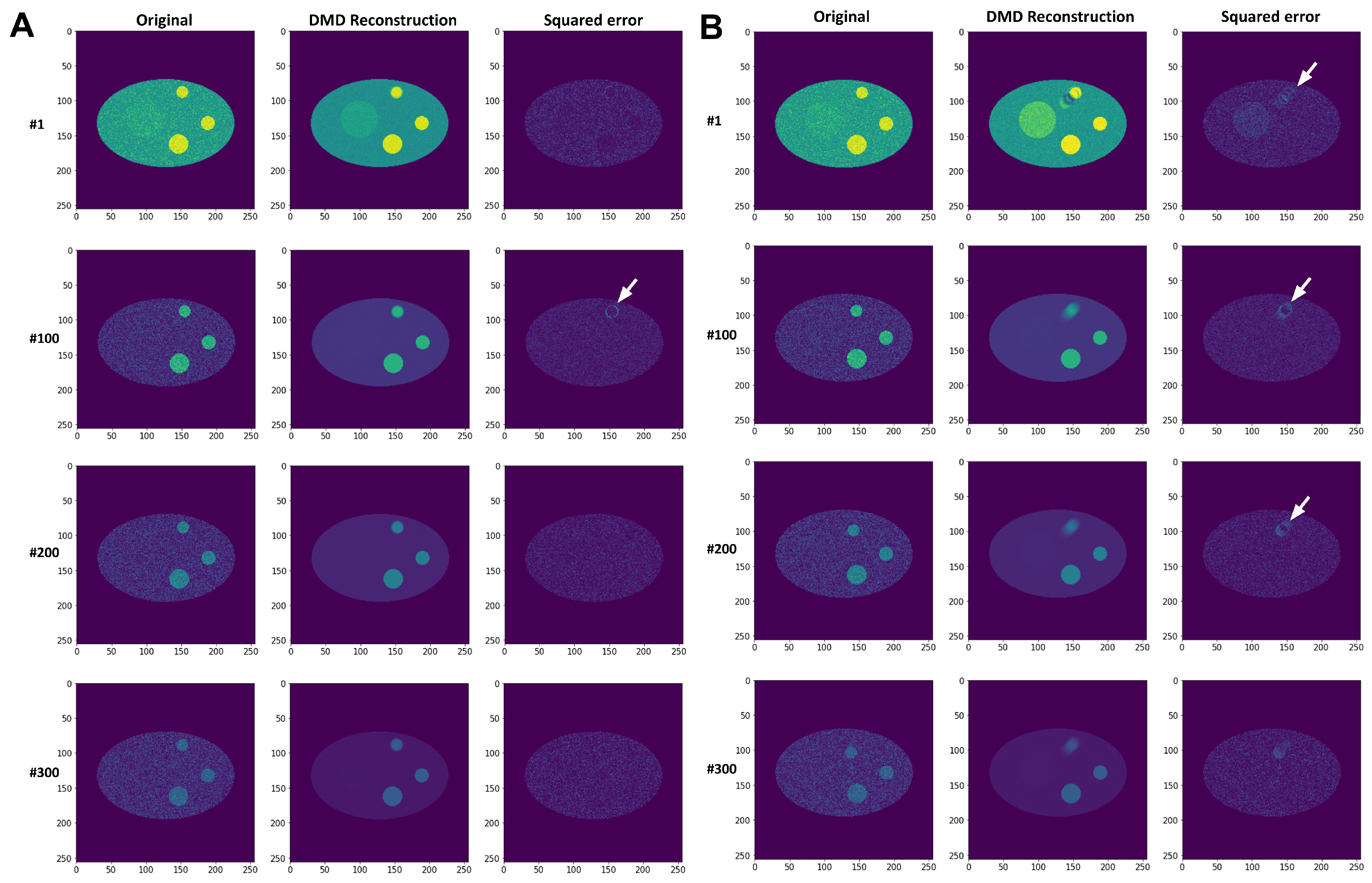
Appendix C. Singular Values and Mode Reconstruction of Experimental FLIP Sequence

Appendix D. Solid-Like Properties of Large eGFP-Q145 Aggregates Determined by FLIP
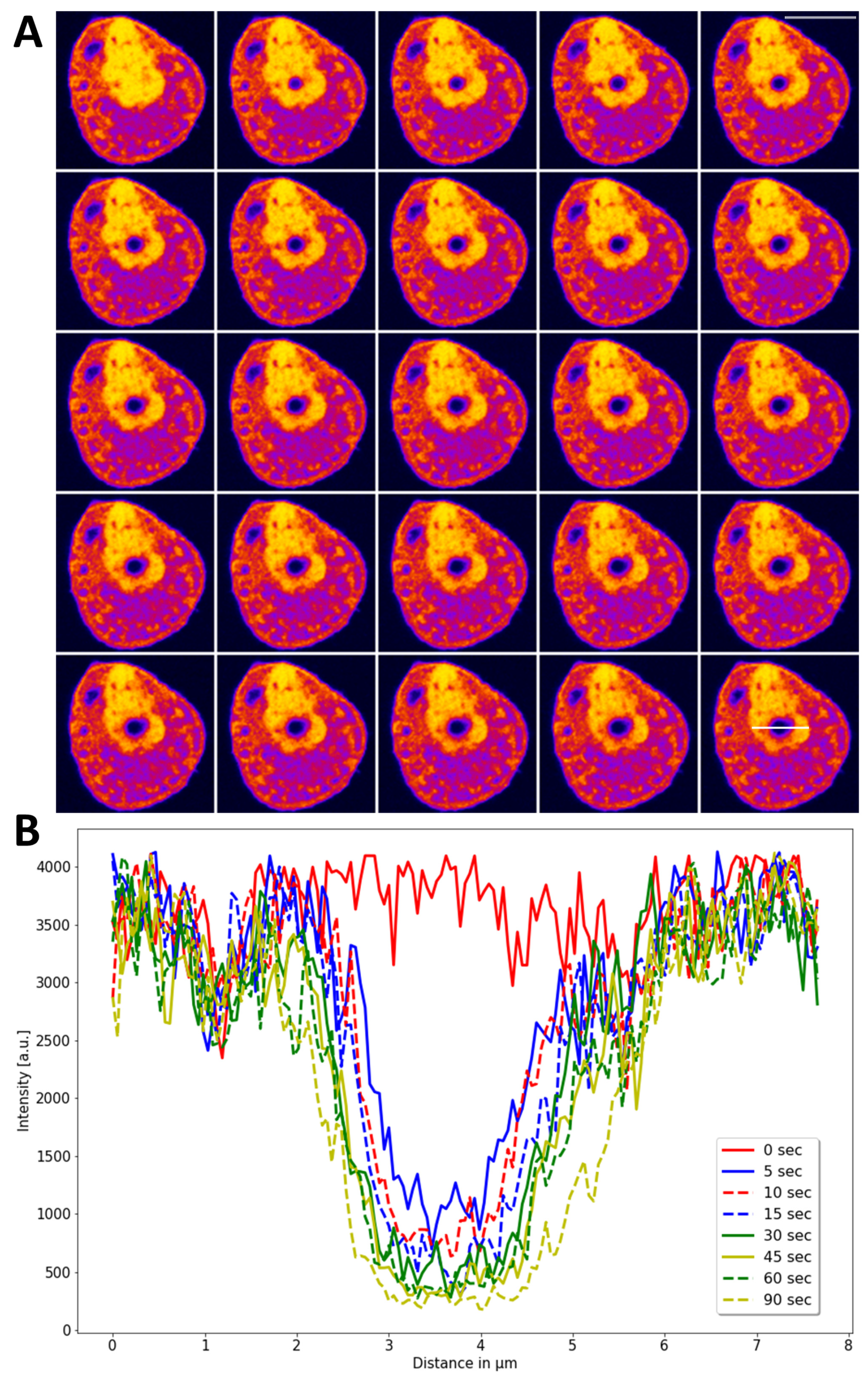
Appendix E. Comparison of Image Denoising Potential of DMD-FLIP Compared to Other Methods
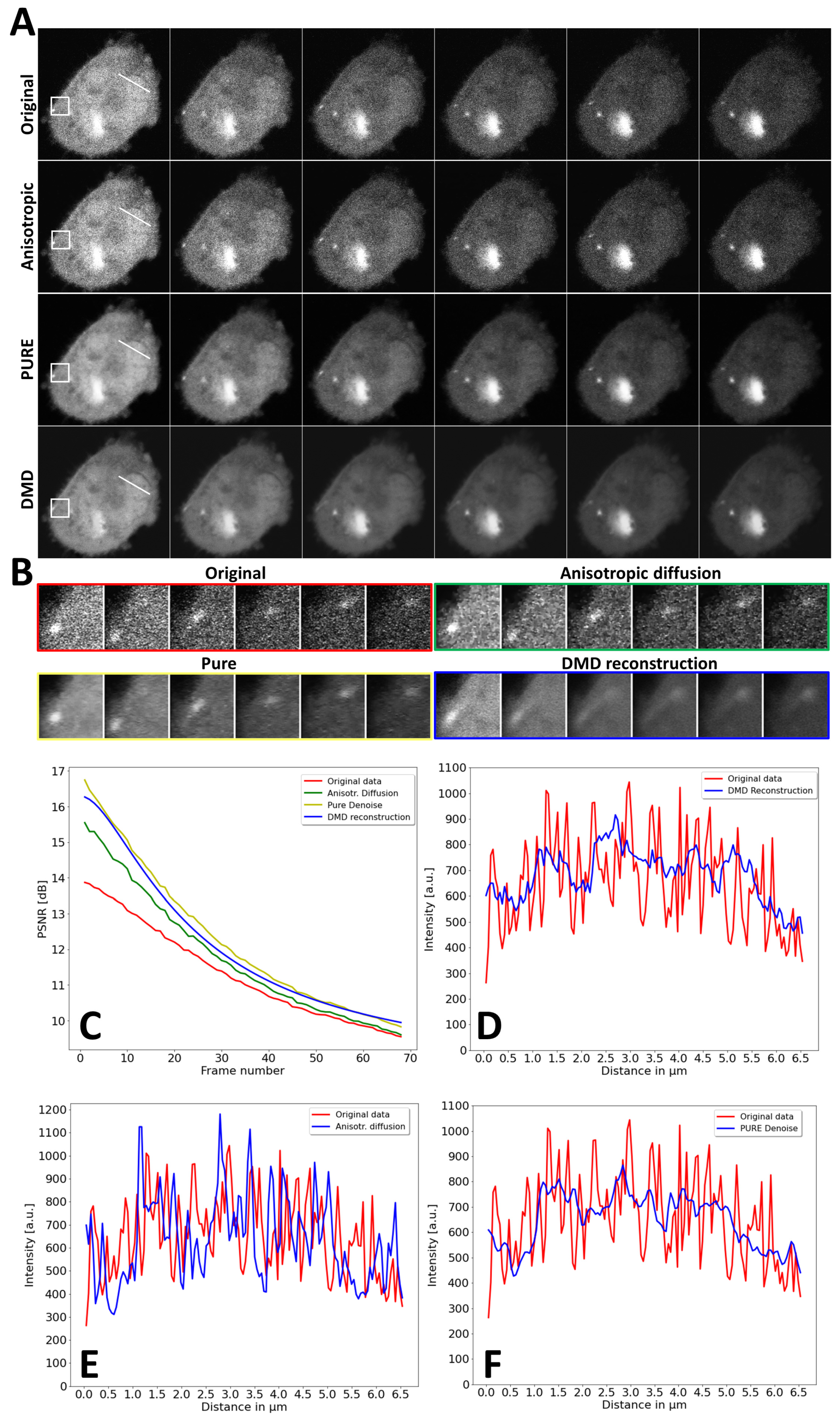

References
- Sprague, B.L.; McNally, J.G. FRAP analysis of binding: Proper and fitting. Trends Cell Biol. 2005, 15, 84–91. [Google Scholar] [CrossRef] [PubMed]
- Reits, E.A.; Neefjes, J.J. From fixed to FRAP: Measuring protein mobility and activity in living cells. Nat. Cell Biol. 2001, 3, E145–E147. [Google Scholar] [CrossRef] [PubMed]
- Ishikawa-Ankerhold, H.C.; Ankerhold, R.; Drummen, G.P. Advanced fluorescence microscopy techniques--FRAP, FLIP, FLAP, FRET and FLIM. Molecules 2012, 17, 4047–4132. [Google Scholar] [CrossRef] [PubMed]
- Bancaud, A.; Huet, S.; Daigle, N.; Mozziconacci, J.; Beaudouin, J.; Ellenberg, J. Molecular crowding affects diffusion and binding of nuclear proteins in heterochromatin and reveals the fractal organization of chromatin. EMBO J. 2009, 28, 3785–3798. [Google Scholar] [CrossRef] [PubMed]
- Gura Sadovsky, R.; Brielle, S.; Kaganovich, D.; England, J.L. Measurement of Rapid Protein Diffusion in the Cytoplasm by Photo-Converted Intensity Profile Expansion. Cell Rep. 2017, 18, 2795–2806. [Google Scholar] [CrossRef]
- Müller, F.; Mazza, D.; Stasevich, T.J.; McNally, J.G. FRAP and kinetic modeling in the analysis of nuclear protein dynamics: What do we really know? Curr. Opin. Cell Biol. 2010, 22, 403–411. [Google Scholar] [CrossRef]
- Hansen, C.V.; Schroll, H.J.; Wustner, D. Computational modeling of fluorescence loss in photobleaching. Comput. Vis. Sci. 2015, 17, 151–166. [Google Scholar] [CrossRef]
- Stasevich, T.J.; Mueller, F.; Michelman-Ribeiro, A.; Rosales, T.; Knutson, J.R.; McNally, J.G. Cross-validating FRAP and FCS to quantify the impact of photobleaching on in vivo binding estimates. Biophys. J. 2010, 99, 3093–3101. [Google Scholar] [CrossRef]
- Mazza, D.; Mueller, F.; Stasevich, T.J.; McNally, J.G. Convergence of chromatin binding estimates in live cells. Nat. Methods 2013, 10, 691–692. [Google Scholar] [CrossRef]
- Mazza, D.; Abernathy, A.; Golob, N.; Morisaki, T.; McNally, J.G. A benchmark for chromatin binding measurements in live cells. Nucleic Acids Res. 2012, 40, e119. [Google Scholar] [CrossRef]
- Wüstner, D.; Solanko, L.M.; Lund, F.W.; Sage, D.; Schroll, J.A.; Lomholt, M.A. Quantitative fluorescence loss in photobleaching for analysis of protein transport and aggregation. BMC Bioinform. 2012, 13, 296. [Google Scholar] [CrossRef] [PubMed]
- Nicholson, L.; Gervasi, N.; Falieres, T.; Leroy, A.; Miremont, D.; Zala, D.; Hanus, C. Whole-Cell Photobleaching Reveals Time-Dependent Compartmentalization of Soluble Proteins by the Axon Initial Segment. Front. Cell Neurosci. 2020, 14, 180. [Google Scholar] [CrossRef] [PubMed]
- Digman, M.A.; Gratton, E. Imaging barriers to diffusion by pair correlation functions. Biophys. J. 2009, 97, 665–673. [Google Scholar] [CrossRef] [PubMed]
- Hinde, E.; Cardarelli, F.; Digman, M.A.; Gratton, E. In vivo pair correlation analysis of EGFP intranuclear diffusion reveals DNA-dependent molecular flow. Proc. Natl. Acad. Sci. USA 2010, 107, 16560–16565. [Google Scholar] [CrossRef]
- Cardarelli, F.; Gratton, E. In vivo imaging of single-molecule translocation through nuclear pore complexes by pair correlation functions. PLoS ONE 2010, 5, e10475. [Google Scholar] [CrossRef]
- Di Rienzo, C.; Cardarelli, F.; Di Luca, M.; Beltram, F.; Gratton, E. Diffusion Tensor Analysis by Two-Dimensional Pair Correlation of Fluorescence Fluctuations in Cells. Biophys. J. 2016, 111, 841–851. [Google Scholar] [CrossRef][Green Version]
- Malacrida, L.; Hedde, P.N.; Ranjit, S.; Cardarelli, F.; Gratton, E. Visualization of barriers and obstacles to molecular diffusion in live cells by spatial pair-cross-correlation in two dimensions. Biomed. Opt. Express. 2018, 9, 303–321. [Google Scholar] [CrossRef]
- Bracha, D.; Walls, M.T.; Brangwynne, C.P. Probing and engineering liquid-phase organelles. Nat. Biotechnol. 2019, 37, 1435–1445. [Google Scholar] [CrossRef]
- Zbinden, A.; Perez-Berlanga, M.; De Rossi, P.; Polymenidou, M. Phase Separation and Neurodegenerative Diseases: A Disturbance in the Force. Dev. Cell 2020, 55, 45–68. [Google Scholar] [CrossRef]
- Kim, S.; Nollen, E.A.; Kitagawa, K.; Bindokas, V.P.; Morimoto, R.I. Polyglutamine protein aggregates are dynamic. Nat. Cell Biol. 2002, 4, 826–831. [Google Scholar] [CrossRef]
- Matsumoto, G.; Kim, S.; Morimoto, R.I. Huntingtin and mutant SOD1 form aggregate structures with distinct molecular properties in human cells. J. Biol. Chem. 2006, 281, 4477–4485. [Google Scholar] [CrossRef] [PubMed]
- Chai, Y.; Shao, J.; Miller, V.M.; Williams, A.; Paulson, H.L. Live-cell imaging reveals divergent intracellular dynamics of polyglutamine disease proteins and supports a sequestration model of pathogenesis. Proc. Natl. Acad. Sci. USA 2002, 99, 9310–9315. [Google Scholar] [CrossRef] [PubMed]
- Irwin, S.; Vandelft, M.; Pinchev, D.; Howell, J.L.; Graczyk, J.; Orr, H.T.; Truant, R. RNA association and nucleocytoplasmic shuttling by ataxin-1. J. Cell Sci. 2005, 118 Pt 1, 233–242. [Google Scholar] [CrossRef]
- Krol, H.A.; Krawczyk, P.M.; Bosch, K.S.; Aten, J.A.; Hol, E.M.; Reits, E.A. Polyglutamine expansion accelerates the dynamics of ataxin-1 and does not result in aggregate formation. PLoS ONE 2008, 3, e1503. [Google Scholar] [CrossRef] [PubMed]
- Lajoie, P.; Snapp, E.L. Formation and toxicity of soluble polyglutamine oligomers in living cells. PLoS ONE 2010, 5, e15245. [Google Scholar] [CrossRef]
- Peskett, T.R.; Rau, F.; O’Driscoll, J.; Patani, R.; Lowe, A.R.; Saibil, H.R. A Liquid to Solid Phase Transition Underlying Pathological Huntingtin Exon1 Aggregation. Mol. Cell 2018, 70, 588–601.e6. [Google Scholar] [CrossRef]
- Elbaum-Garfinkle, S. Matter over mind: Liquid phase separation and neurodegeneration. J. Biol. Chem. 2019, 294, 7160–7168. [Google Scholar] [CrossRef]
- Stenoien, D.L.; Mielke, M.; Mancini, M.A. Intranuclear ataxin1 inclusions contain both fast- and slow-exchanging components. Nat. Cell Biol. 2002, 4, 806–810. [Google Scholar] [CrossRef]
- Kitamura, A.; Kubota, H.; Pack, C.G.; Matsumoto, G.; Hirayama, S.; Takahashi, Y.; Kimura, H.; Kinjo, M.; Morimoto, R.I.; Nagata, K. Cytosolic chaperonin prevents polyglutamine toxicity with altering the aggregation state. Nat. Cell Biol. 2006, 8, 1163–1170. [Google Scholar] [CrossRef]
- Snapp, E.L.; Hegde, R.S.; Francolini, M.; Lombardo, F.; Colombo, S.; Pedrazzini, E.; Borgese, N.; Lippincott-Schwartz, J. Formation of stacked ER cisternae by low affinity protein interactions. J. Cell Biol. 2003, 163, 257–269. [Google Scholar] [CrossRef]
- Lu, M.; Banetta, L.; Young, L.J.; Smith, E.J.; Bates, G.P.; Zaccone, A.; Kaminski Schierle, G.S.; Tunnacliffe, A.; Kaminski, C.F. Live-cell super-resolution microscopy reveals a primary role for diffusion in polyglutamine-driven aggresome assembly. J. Biol. Chem. 2019, 294, 257–268. [Google Scholar] [CrossRef] [PubMed]
- Laine, R.F.; Sinnige, T.; Ma, K.Y.; Haack, A.J.; Poudel, C.; Gaida, P.; Curry, N.; Perni, M.; Nollen, E.A.A.; Dobson, C.M.; et al. Fast Fluorescence Lifetime Imaging Reveals the Aggregation Processes of alpha-Synuclein and Polyglutamine in Aging Caenorhabditis elegans. ACS Chem. Biol. 2019, 14, 1628–1636. [Google Scholar] [CrossRef] [PubMed]
- Ossato, G.; Digman, M.A.; Aiken, C.; Lukacsovich, T.; Marsh, J.L.; Gratton, E. A two-step path to inclusion formation of huntingtin peptides revealed by number and brightness analysis. Biophys. J. 2010, 98, 3078–3085. [Google Scholar] [CrossRef] [PubMed]
- Li, L.; Liu, H.; Dong, P.; Li, D.; Legant, W.R.; Grimm, J.B.; Lavis, L.D.; Betzig, E.; Tjian, R.; Liu, Z. Real-time imaging of Huntingtin aggregates diverting target search and gene transcription. eLife 2016, 5, e17056. [Google Scholar] [CrossRef]
- Sahl, S.J.; Lau, L.; Vonk, W.I.; Weiss, L.E.; Frydman, J.; Moerner, W.E. Delayed emergence of subdiffraction-sized mutant huntingtin fibrils following inclusion body formation. Q. Rev. Biophys. 2016, 49, e2. [Google Scholar] [CrossRef]
- Sahl, S.J.; Weiss, L.E.; Duim, W.C.; Frydman, J.; Moerner, W.E. Cellular inclusion bodies of mutant huntingtin exon 1 obscure small fibrillar aggregate species. Sci. Rep. 2012, 2, 895. [Google Scholar] [CrossRef]
- Bhardwaj, V.; Panicker, M.M.; Udgaonkar, J.B. Fluorescence anisotropy uncovers changes in protein packing with inclusion growth in a cellular model of polyglutamine aggregation. Biochemistry 2014, 53, 3621–3636. [Google Scholar] [CrossRef]
- Caron, N.S.; Hung, C.L.; Atwal, R.S.; Truant, R. Live cell imaging and biophotonic methods reveal two types of mutant huntingtin inclusions. Hum. Mol. Genet. 2014, 23, 2324–2338. [Google Scholar] [CrossRef]
- Hansen, C.V.; Schroll, H.J.; Wüstner, D. A discontinuous Galerkin model for fluorescence loss in photobleaching of intracellular polyglutamine protein aggregates. BMC Biophys. 2018, 11, 7. [Google Scholar] [CrossRef]
- Hansen, C.V.; Schroll, H.J.; Wustner, D. A Discontinuous Galerkin Model for Fluorescence Loss in Photobleaching. Sci. Rep. 2018, 8, 1387. [Google Scholar] [CrossRef]
- Schmid, P.J. Dynamic mode decomposition of numerical and experimental data. J. Fluid Mech. 2010, 656, 5–28. [Google Scholar] [CrossRef]
- Brunton, S.L.; Kutz, J.N. Data-Driven Science and Engineering: Machine Learning, Dynamical Systems, and Control; Cambridge University Press: Cambridge, UK, 2019. [Google Scholar]
- Bi, C.; Yuan, Y.; Zhang, J.W.; Shi, Y.; Xiang, Y.; Wang, Y.; Zhang, R.H. Dynamic Mode Decomposition Based Video Shot Detection. IEEE Access 2018, 6, 21397–21407. [Google Scholar] [CrossRef]
- Kutz, J.N.; Fu, X.; Brunton, S.L.; Erichson, N.B. Multi-resolution dynamic mode decomposition for foreground/background separation and object tracking. In Proceedings of the 2015 IEEE International Conference on Computer Vision Workshop, Santiago, Chile, 7–13 December 2015. [Google Scholar]
- Tirunagari, S.; Poh, N.; Wells, K.; Bober, M.; Gorden, I.; Windridge, D. Functional Segmentation through Dynamic Mode Decomposition: Automatic Quantification of Kidney Function in DCE-MRI Images. arXiv 2019, arXiv:1905.10218. [Google Scholar]
- Casorso, J.; Kong, X.; Chi, W.; Van De Ville, D.; Yeo, B.T.T.; Liegeois, R. Dynamic mode decomposition of resting-state and task fMRI. Neuroimage 2019, 194, 42–54. [Google Scholar] [CrossRef]
- Wüstner, D. Image segmentation and separation of spectrally similar dyes in fluorescence microscopy by dynamic mode decomposition of photobleaching kinetics. BioRxiv 2022, bioRxiv:2022.02.28.482234. [Google Scholar]
- Erichson, N.B.J.; Brunton, S.L.; Kutz, N. Compressed dynamic mode decomposition for background modeling. J. Real-Time Image Process. 2019, 16, 1479–1492. [Google Scholar] [CrossRef]
- Gavish, M.; Donoho, D.L. The optimal hard threshold for singular values is 4/sqrt(3). IEEE Trans. Inf. Theory 2014, 60, 5040–5063. [Google Scholar] [CrossRef]
- Demo, N.; Tezzele, M.; Rozza, G. PyDMD: Python Dynamic Mode Decomposition. J. Open Source Softw. 2018, 3, 530. [Google Scholar] [CrossRef]
- Brandt, S. Datenanalyse; Springer: Berlin/Heidelberg, Germany, 1999. [Google Scholar]
- Barlett, V.R.; Hoyuelos, M.; Martin, H.O. Comparison between fixed and Gaussian steplength in Monte Carlo simulations for diffusion processes. J Comput. Phys. 2011, 230, 3719–3726. [Google Scholar] [CrossRef]
- Istratov, A.A.; Vyvenko, O.F. Exponential analysis in physical phenomena. Rev. Sci. Instrum. 1999, 70, 1233–1257. [Google Scholar] [CrossRef]
- Tschumperle, D.; Deriche, R. Vector-valued image regularization with PDE’s: A common framework for different applications. IEEE Trans. Pattern Anal. Mach. Intell. 2005, 27, 506–517. [Google Scholar] [CrossRef] [PubMed]
- Delpretti, S.; Luisier, F.; Ramani, S.; Blu, T.; Unser, M. Multiframe SURE-LET denoising of timelapse fluorescence microscopy images. In Proceedings of the 5th IEEE International Symposium on Biomedical Imaging: From Nano to Macro, Paris, France, 14–17 May 2008; pp. 149–152. [Google Scholar]
- Viguerie, A.; Barros, G.F.; Grave, M.; Reali, A.; Coutinho, A.L. Coupled and uncoupled dynamic mode decomposition in multi-compartmental systems with applications to epidoemiological and additive manufacturing problems. Comput. Methods Appl. Mech. Eng. 2022, 391, 114600. [Google Scholar] [CrossRef]
- Le Clainche, S.; Vega, J.M. Higher order dynamic mode decomposition. SIAM J. Appl. Dyn. Sys. 2017, 16, 882–925. [Google Scholar] [CrossRef]
- Baddoo, P.J.; Herrmann, B.; McKeon, B.J.; Kutz, J.N.; Brunton, S.L. Physics-informed dynamic mode decomposition (piDMD). arXiv 2021, arXiv:2112.04307. [Google Scholar]
- Williams, M.O.; Kevrekidis, I.G.; Rowley, C.W. A Data–Driven Approximation of the Koopman Operator: Extending Dynamic Mode Decomposition. J. Nonlinear Sci. 2015, 25, 1307–1346. [Google Scholar] [CrossRef]
- Rudy, S.H.; Brunton, S.L.; Proctor, J.L.; Kutz, J.N. Data-driven discovery of partial differential equations. Sci. Adv. 2017, 3, e1602614. [Google Scholar] [CrossRef]
- Wüstner, D.; Christensen, T.; Solanko, L.M.; Sage, D. Photobleaching kinetics and time-integrated emission of fluorescent probes in cellular membranes. Molecules 2014, 19, 11096–11130. [Google Scholar] [CrossRef]
- Cardarelli, F.; Tosti, L.; Serresi, M.; Beltram, F.; Bizzarri, R. Fluorescent recovery after photobleaching (FRAP) analysis of nuclear export rates identifies intrinsic features of nucleocytoplasmic transport. J. Biol. Chem. 2012, 287, 5554–5561. [Google Scholar] [CrossRef]
- Wüstner, D. Mathematical analysis of hepatic high density lipoprotein transport based on quantitative imaging data. J. Biol. Chem. 2005, 280, 6766–6779. [Google Scholar] [CrossRef]

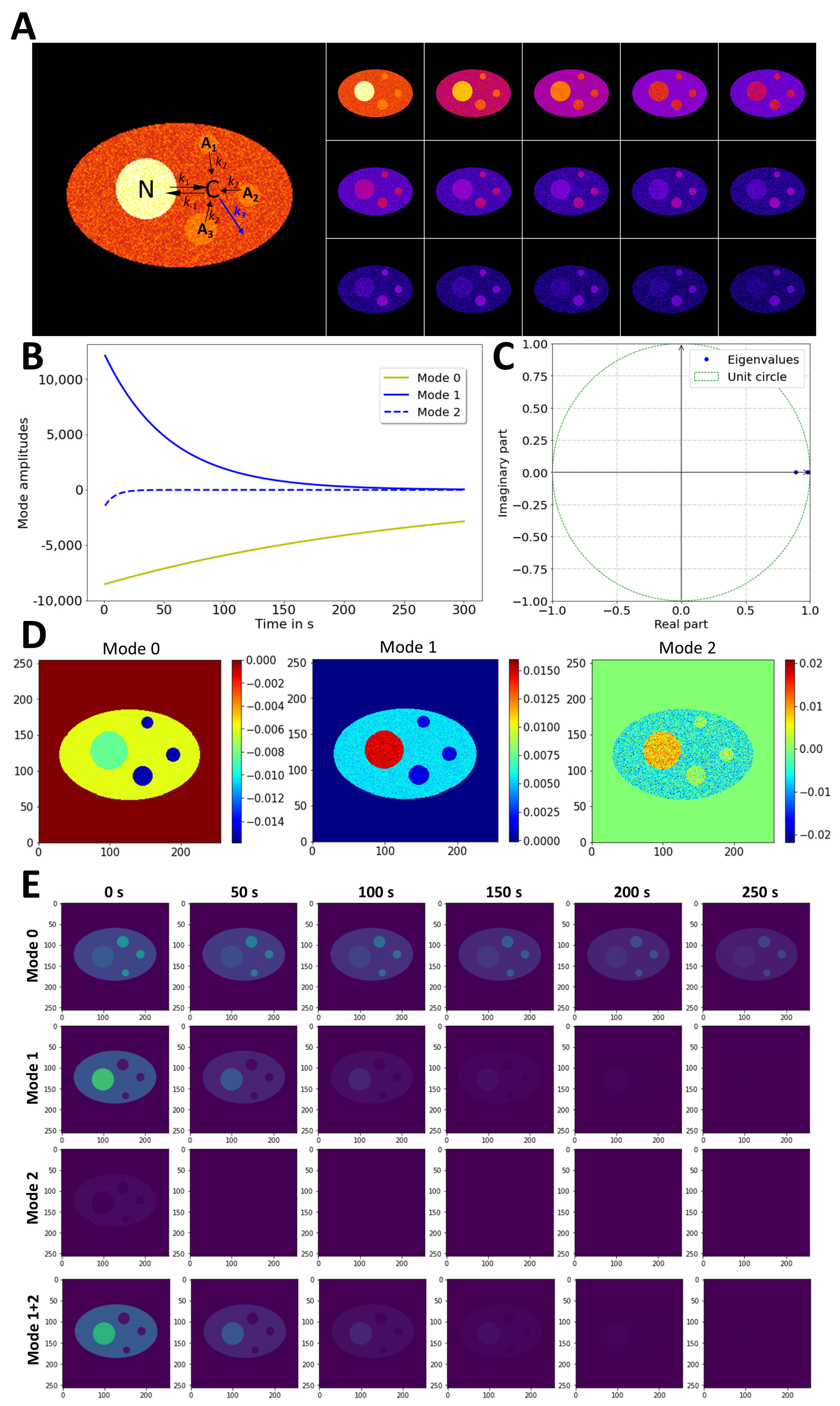
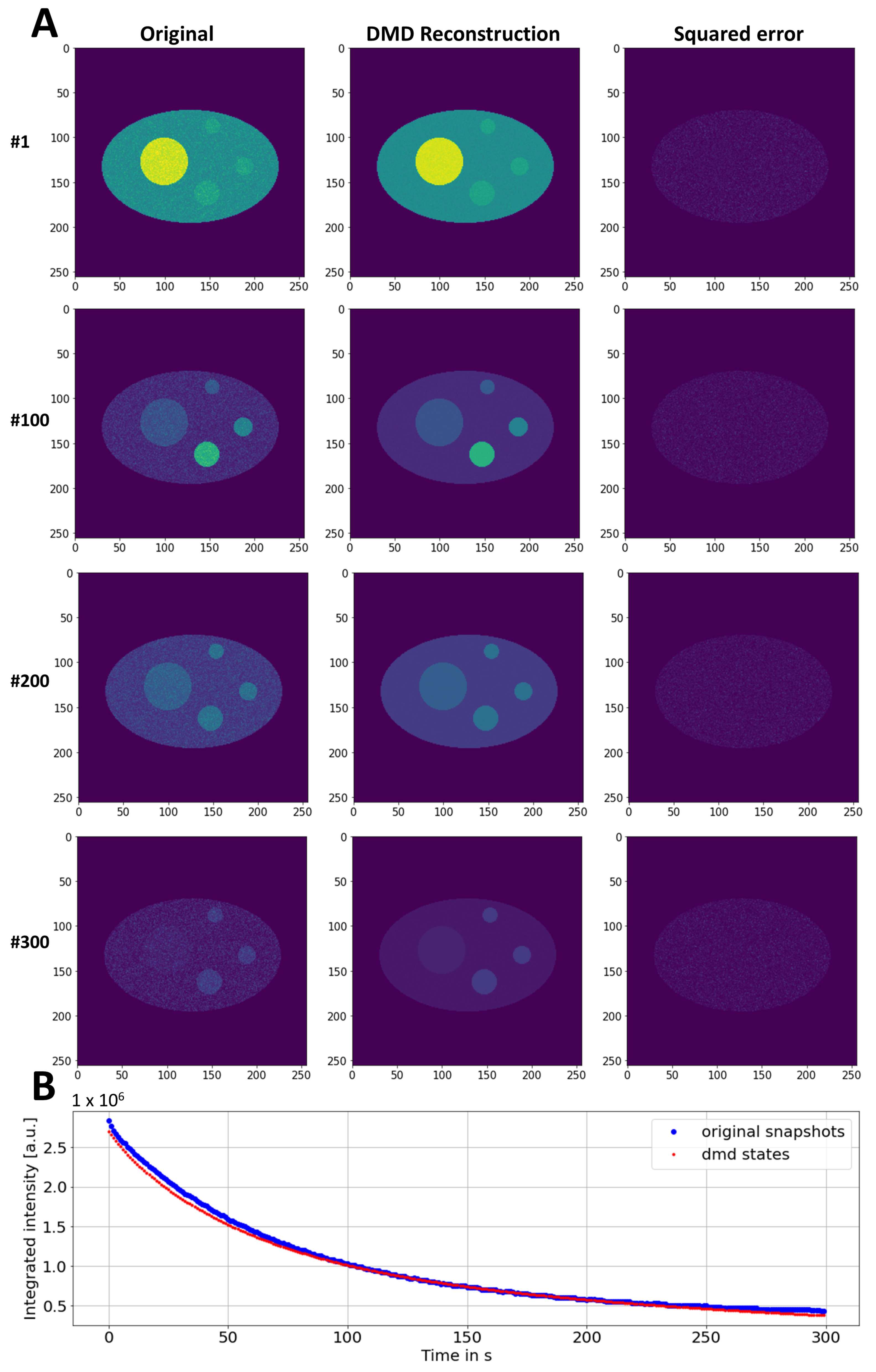
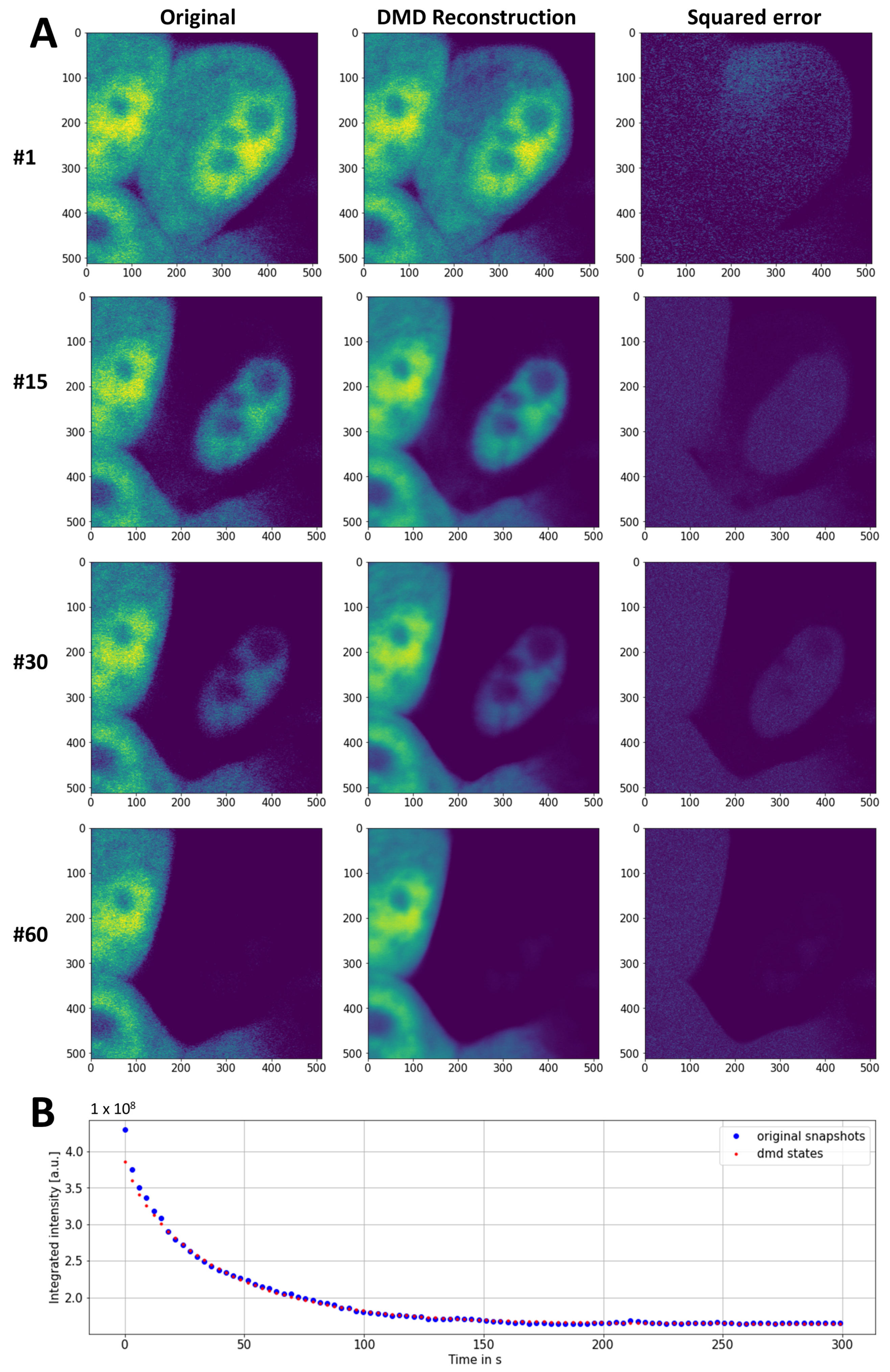

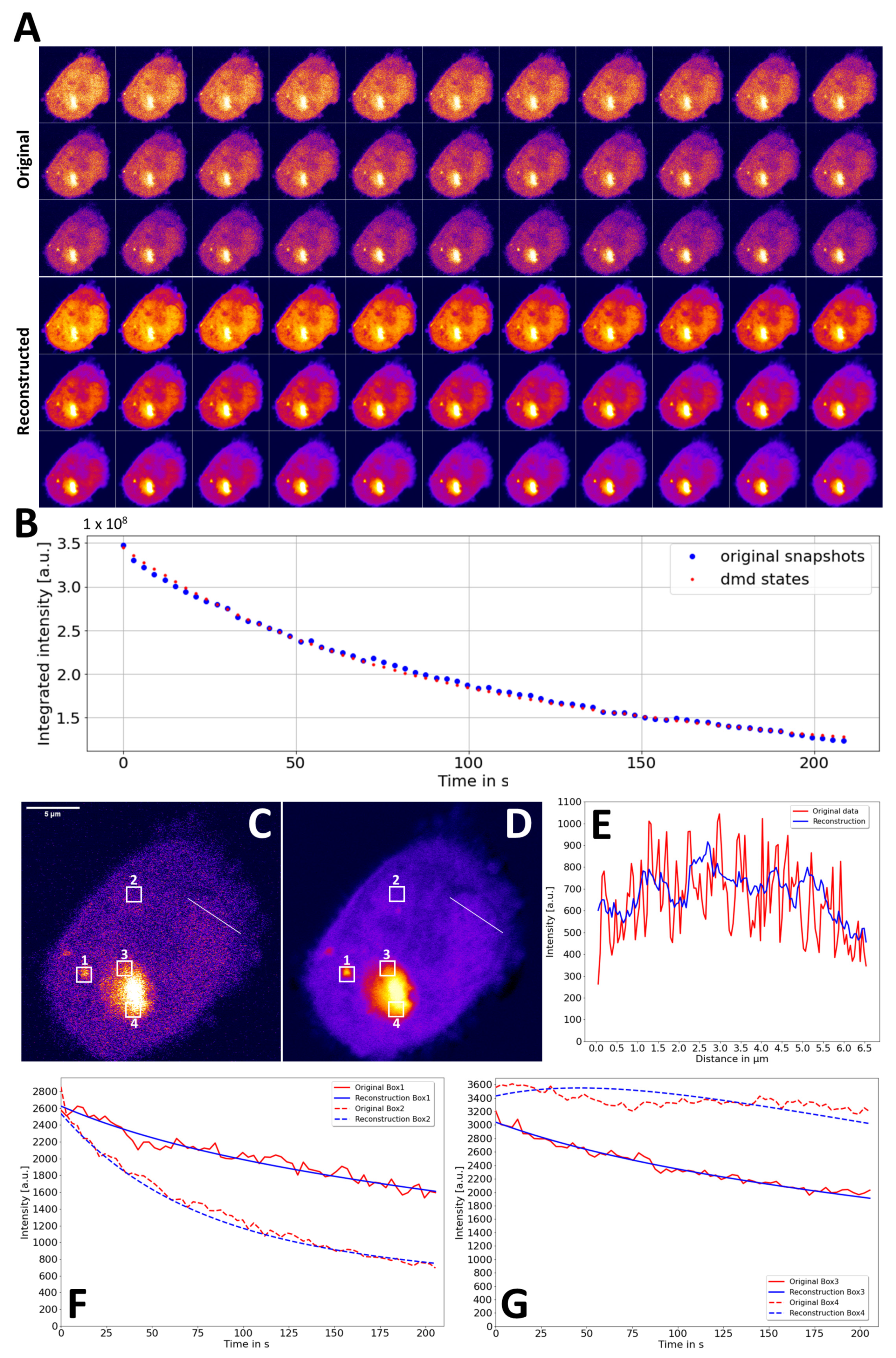

| Eigenvalues * | FLIP Simulation | DMD Reconstruction | Pixel-Wise Fitting # |
|---|---|---|---|
| l1 = −0.0050 s−1 | ω0 = −0.0038 s−1 | kagg. = −0.0051 s−1 | |
| l2 = −0.6342 s−1 | ω2 = −0.1162 s−1 | - | |
| l3 = −0.0158 s−1 | ω1 = −0.0189 s−1 | kcell. = −0.0139 s−1 |
Publisher’s Note: MDPI stays neutral with regard to jurisdictional claims in published maps and institutional affiliations. |
© 2022 by the author. Licensee MDPI, Basel, Switzerland. This article is an open access article distributed under the terms and conditions of the Creative Commons Attribution (CC BY) license (https://creativecommons.org/licenses/by/4.0/).
Share and Cite
Wüstner, D. Dynamic Mode Decomposition of Fluorescence Loss in Photobleaching Microscopy Data for Model-Free Analysis of Protein Transport and Aggregation in Living Cells. Sensors 2022, 22, 4731. https://doi.org/10.3390/s22134731
Wüstner D. Dynamic Mode Decomposition of Fluorescence Loss in Photobleaching Microscopy Data for Model-Free Analysis of Protein Transport and Aggregation in Living Cells. Sensors. 2022; 22(13):4731. https://doi.org/10.3390/s22134731
Chicago/Turabian StyleWüstner, Daniel. 2022. "Dynamic Mode Decomposition of Fluorescence Loss in Photobleaching Microscopy Data for Model-Free Analysis of Protein Transport and Aggregation in Living Cells" Sensors 22, no. 13: 4731. https://doi.org/10.3390/s22134731
APA StyleWüstner, D. (2022). Dynamic Mode Decomposition of Fluorescence Loss in Photobleaching Microscopy Data for Model-Free Analysis of Protein Transport and Aggregation in Living Cells. Sensors, 22(13), 4731. https://doi.org/10.3390/s22134731






